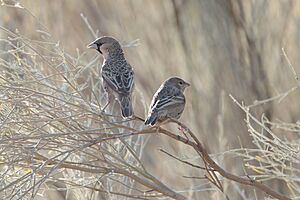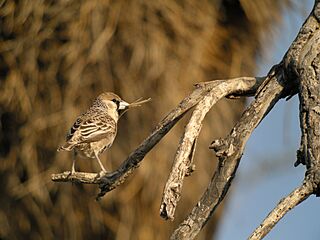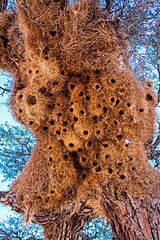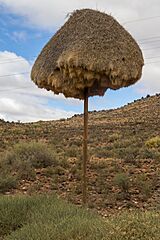Sociable weaver facts for kids
Quick facts for kids Sociable weaver |
|
|---|---|
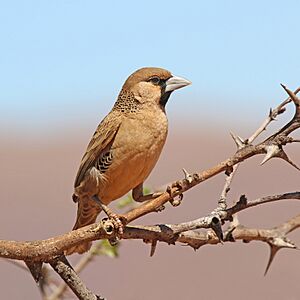 |
|
| At Tswalu Kalahari Reserve, South Africa | |
| Conservation status | |
| Scientific classification | |
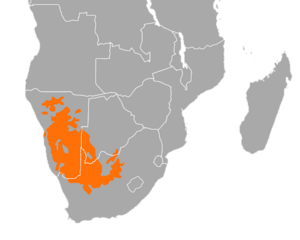 |
|
| range centred on the Kalahari, Namib and northern Karoo regions |
The sociable weaver (its scientific name is Philetairus socius) is a special kind of bird found only in Southern Africa. It belongs to the weaver family. This bird is the only one of its kind in the Philetairus group. You can find sociable weavers in South Africa, Namibia, and Botswana. They are most common in the Northern Cape Province of South Africa. These birds are famous for building huge, shared nests. These nests are some of the most amazing structures made by any bird!
Contents
About the Sociable Weaver
The sociable weaver was first described by a bird expert named John Latham in 1790. People sometimes call it the common social weaver or just the social weaver. There used to be different types of sociable weavers, but now scientists agree there is only one main type.
What Does a Sociable Weaver Look Like?
Sociable weavers are about 14 cm (5+1⁄2 in) long. That's about the length of a small ruler. They have a black chin and black stripes on their sides. Their backs look like they have a pattern of scales. These birds usually weigh between 26–32 g (15⁄16–1+1⁄8 oz). Male and female sociable weavers look very much alike.
Where Sociable Weavers Live
Sociable weavers live in northwestern South Africa, southwest Botswana, and up into Namibia. They love the dry, grassy areas of the southern Kalahari region. They need tough grasses like Stipagrostis ciliata to build their nests. These grasses are very important for where the birds choose to live. The northern parts of the Kalahari have taller grasses and more fires, which might be why these birds are not found there. The areas where they live are usually dry with little rain, mostly in the summer. There are many sociable weavers, so they are not considered rare.
Sociable Weaver Life and Habits
Sociable weavers have interesting ways of living and raising their young.
Reproduction and Family Life
In the southern parts of their home, sociable weavers can breed at any time of the year. Their breeding depends a lot on when it rains. In the northern areas, they usually breed between December and August. If there isn't much rain, they might not breed at all. Sometimes, more than half the birds in a group might not breed in a certain year.
When conditions are good, a pair of weavers can raise up to four groups of babies in one breeding period. Sociable weavers are known for helping each other. Almost all bird pairs get help from other birds in the group. These helpers assist in taking care of younger brothers, sisters, or even baby birds that are not related to them. One pair of birds was seen raising nine groups of babies in one season! This happened because their young kept getting eaten by predators. Unlike many other birds, sociable weavers don't start breeding in their first year. They often wait until they are up to two years old.
Building Amazing Nests
Sociable weavers build huge, permanent nests on trees or other tall structures. These nests are some of the biggest ever built by birds! They can be large enough to hold over 100 pairs of birds. Many generations of birds can live in the same nest at once.
These nests are very well-built. They help the birds stay comfortable. The rooms in the middle of the nest stay warm. Birds use these central rooms to sleep at night. The outer rooms provide shade during the day. Inside the occupied rooms, the temperature changes only a little, about 7–8 °C (45–46 °F). But outside, the temperature can change a lot, from 16 to 33.5 °C (60.8 to 92.3 °F).
Each nest has many separate rooms. Each room is used by one pair of birds (and sometimes their babies) for sleeping and breeding. The birds build their nests around strong trees like Acacia erioloba, Boscia albitrunca, and Aloidendron dichotomum. Sometimes, they even build nests on telephone poles! Some nests have been active for over 100 years, with many generations of birds living in them.
From far away, a sociable weaver nest looks like a giant haystack in a tree. If you look up from below, you can see the entrances to the different rooms. It looks a bit like a honeycomb! These entrances are about 3 in (76 mm) wide and can be up to 10 in (250 mm) long. The birds sometimes place sharp sticks near the entrances to keep predators away.
Other Animals in the Nest
Sociable weaver nests are like apartment buildings for many other animals. Several other bird species use the nests. Some birds, like the paradise finch and rosy-faced lovebird, use the nests to breed. Others, like the familiar chat and ashy tit, use them just for sleeping. Even larger birds, such as owls, vultures, or falcons, sometimes use the nests as a platform for their own nests. Most birds live peacefully with the weavers. However, the pygmy falcon has sometimes been known to eat baby weavers.
Reptiles also use the nests. Snakes, especially Cape cobras and boomslangs, are common predators. They often eat all the eggs in a large nest. In one study, 70% of the eggs laid were eaten by predators. A type of lizard called the Kalahari Tree Skink (Trachylepis spilogaster) also lives near the nests. Trees with nests seem to have more skinks than trees without nests. These skinks have even learned to listen to the weavers' alarm calls. This helps them know when a pygmy falcon, one of their main predators, is coming!
Sometimes, nests built on electricity poles can cause problems. They might cause power outages in the rainy season or even catch fire in the dry season.
What Sociable Weavers Eat
Sociable weavers mostly eat insects, which make up about 80% of their diet. Since they live in the dry Kalahari Desert where water is scarce, they get all the water they need from the food they eat. They also eat seeds and other plant parts. They usually look for food on the ground, but also on tree bark and leaves.
Sociable Weaver Population Status
The number of sociable weavers has grown since 2010. This might be because there are more places for them to build nests, like electricity poles and other structures made by people. Most of the areas where they live now are not likely to change much because of human activity. So, their future in these places seems safe. However, in some parts of the Northern Cape Province, their numbers might be lower. This could be due to people clearing Acacia trees, which are important for their nests. Also, too much grazing by animals in some areas can cause the birds to disappear from those spots.
Gallery



